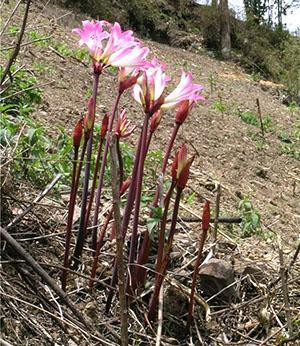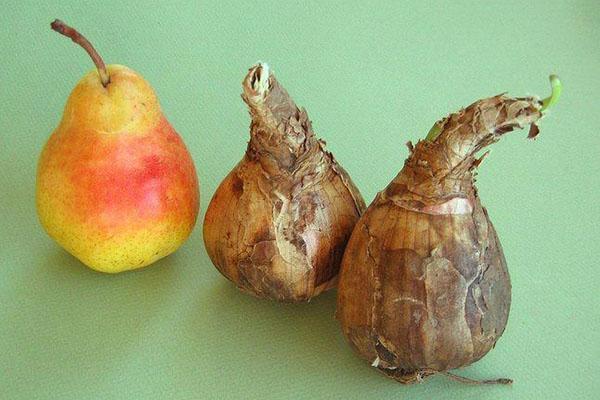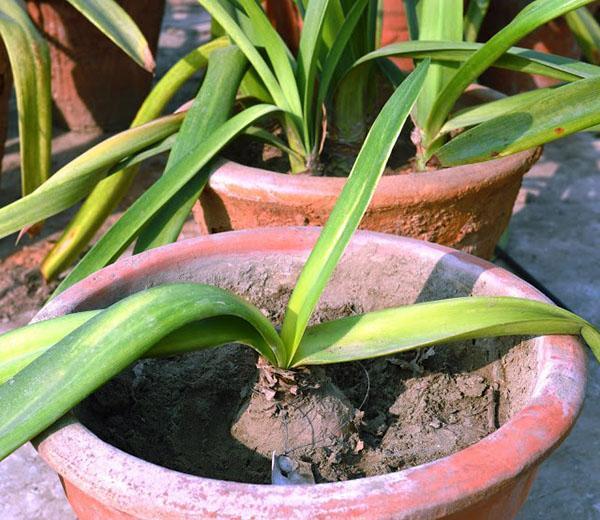Planting and caring for amaryllis at home
 South African amaryllis, which gave the name to an extensive family of ornamental bulbous plants and their own genus, are not as well known to Russian flower growers as their relatives: hippeastrum, daffodil, galanthus, clivia and onion.
South African amaryllis, which gave the name to an extensive family of ornamental bulbous plants and their own genus, are not as well known to Russian flower growers as their relatives: hippeastrum, daffodil, galanthus, clivia and onion.
But in the homeland of the plant, as well as in Australia and in the southern states of the United States, where amaryllis were exported more than a hundred years ago, the culture has already become common. Slender flower stalks up to 70 cm high can be found not only on alpine slides and in the design of borders, but even on garbage heaps. This is due to the simplicity of caring for amaryllis and the peculiarities of plant reproduction, which instead of the usual dry seeds give juicy, ready-to-germinate bulbs.

Air temperature of –9 ° C becomes critical for them. Elongated green foliage and flowers of the culture suffer even with less frost. Therefore, in the middle lane, amaryllis are indoor plants with a pronounced growing season and dormant time.
Amaryllis life cycle and home care
 Blooming of the indigenous inhabitants of South Africa occurs in autumn, which begins in March in the southern hemisphere and ends in May. It was this circumstance that determined one of the local names of the amaryllis - Easter lily. The bulb, awakened after a summer vacation, produces one or two bare peduncles, crowned with several large buds. The inflorescence can include up to 12 buds, and hybrid plants produce up to 20 flowers at a time.
Blooming of the indigenous inhabitants of South Africa occurs in autumn, which begins in March in the southern hemisphere and ends in May. It was this circumstance that determined one of the local names of the amaryllis - Easter lily. The bulb, awakened after a summer vacation, produces one or two bare peduncles, crowned with several large buds. The inflorescence can include up to 12 buds, and hybrid plants produce up to 20 flowers at a time.
The flowering of amaryllis at home lasts from 6 to 8 weeks, and only after the flower stalks wither, dense leaves appear above the ground.
They remain for the whole winter, when the foliage dries up, this indicates the approach of a new dormant period, during which the bulbs need to be kept dry at a temperature of about + 10 ° C.
How to care for amaryllis at this time? Until the bulb shows signs of life, it is important to protect it from drying out and decay. If the air temperature is higher, in order to prevent the death of the root system, it is advisable to slightly moisten the top layer of the soil. At low temperatures, watering is dangerous, as it threatens the development of rot and fungal infections.
 During growth and flowering, caring for amaryllis at home consists in creating comfortable conditions, watering and feeding the plants. The optimum air temperature in the room where this culture is kept varies between:
During growth and flowering, caring for amaryllis at home consists in creating comfortable conditions, watering and feeding the plants. The optimum air temperature in the room where this culture is kept varies between:
- 20-22 ° C during daytime;
- 18–20 ° C at night.
Amaryllis do not like it when the temperature background or humidity changes dramatically in the room. At home, plants grow on mountainous slopes, where the air is not too saturated with water vapor. At home, amaryllis also does not need high air humidity, which provokes the development of fungi under dry scales.
 Caring for amaryllis is impossible without watering and feeding the plant. It is necessary to moisten the soil around the bulb when the top layer of the substrate dries. Irrigation water is pre-defended or filtered.
Caring for amaryllis is impossible without watering and feeding the plant. It is necessary to moisten the soil around the bulb when the top layer of the substrate dries. Irrigation water is pre-defended or filtered.
Fertilization is carried out two weeks later during the flowering of plants, and then with the active growth of foliage. It is best to use formulations for flowering crops with a predominance phosphorus and potassium. An excess of nitrogen slows down the development of buds, such a bulb leaves foliage abundantly, and is also susceptible to red burns - a common disease of bulbous.
Features of planting amaryllis
 Most types of bulbous crops are transplanted at home before the start of the new growing season. This is not true for amaryllis. It is more useful for this inhabitant of southern Africa to be in a new soil immediately after the flower stalks wither, when the growth of leaves is just beginning. Such a measure of caring for amaryllis, as in the photo, will allow the plant to quickly restore the reserve of strength expended during flowering and prepare for the coming period of rest.
Most types of bulbous crops are transplanted at home before the start of the new growing season. This is not true for amaryllis. It is more useful for this inhabitant of southern Africa to be in a new soil immediately after the flower stalks wither, when the growth of leaves is just beginning. Such a measure of caring for amaryllis, as in the photo, will allow the plant to quickly restore the reserve of strength expended during flowering and prepare for the coming period of rest.
To facilitate the release of the earthen coma and roots from the old container, the soil under the bulb is abundantly moistened. The pot is removed so as to preserve the maximum number of roots and soil on them. Then the bulb is transferred into a new container, larger than the previous one, with a prepared drainage layer and a small amount of moist fertile substrate. The free spaces around the coma are filled with soil, which is subsequently compacted and watered a little.
It must be remembered that after transplanting, the amaryllis bulb remains 1–2 thirds above the soil level, and the distance from it to the edge of the pot should not exceed 3 cm.
Powerful roots dry out easily, so when transferring a crop from one pot to another, the underground part of the plant must remain moist. When babies with their own root system are found on an adult bulb, they are separated and planted in separate pots of a suitable size.
The soil for planting amaryllis should be loose, light and have an acidity level of about 6.0-6.5. If it is not possible to purchase a ready-made mixture for decorative bulbous, the substrate is made independently. To do this, take:
- in equal amounts sod and leafy land;
- half the amount of humus and the same amount peat;
- a small amount of perlite, which can be replaced with coarse sand or adding vermiculite to the soil.
Before planting the bulbs, the substrate for amaryllis at home must be steamed or disinfected in another way. If this is not done, the succulent roots and scales attract the attention of a variety of insect pests from onion flies to nematodes.
When deciding to transplant in the summer, when the amaryllis is in full swing, the grower can disrupt the natural life cycle and lose the opportunity to admire the bright flowering of the South African plant for a year or two.
 The main enemies of amaryllis when growing at home:
The main enemies of amaryllis when growing at home:
- excessive watering, as a result of which decay of the root system and the bottom of the bulb begins;
- lack of conditions during the "hibernation" of culture;
- low air temperature, for example, when taking the pot out to the balcony or garden;
- a dense substrate in which the roots lack oxygen.
Caring for amaryllis at home is quite laborious, requires attention and understanding of the life processes occurring in the bulb. Therefore, before starting a South African "naked lady" in an apartment, a novice florist can master agricultural techniques on less fastidious relatives of amaryllis: hippeastrum and clivia.
Reproduction of amaryllis at home
 Amaryllis, like other bulbous, can be propagated at home using:
Amaryllis, like other bulbous, can be propagated at home using:
- children formed on adult bulbs;
- different options for dividing the bulbs;
- seeds.
Vegetative propagation methods do not have any peculiarities. And here are the seeds amaryllis, as in the photo, differ significantly from those that are formed after pollination of other closely related species.
 These are not dry black scales, like in the hippeastrum, but juicy small bulbs even inside the fruit sometimes giving roots and forming a tiny sprout.On the one hand, such planting material makes it easier to get new plants, but on the other hand, it is very difficult to prevent tiny bulbs from germinating.
These are not dry black scales, like in the hippeastrum, but juicy small bulbs even inside the fruit sometimes giving roots and forming a tiny sprout.On the one hand, such planting material makes it easier to get new plants, but on the other hand, it is very difficult to prevent tiny bulbs from germinating.
Within a few weeks after pollination of amaryllis at home, the bulbs are ready to give life to young specimens. Therefore, do not hesitate. The seeds are sown, slightly deepening the bottom, into a wet mixture of peat and sand and placed in a well-lit place.
 It takes 3 to 6 weeks for greens to take root and appear. With proper care, seed-grown amaryllis bloom in 4–5 years.
It takes 3 to 6 weeks for greens to take root and appear. With proper care, seed-grown amaryllis bloom in 4–5 years.
Depending on the development and size of the bulbs, in the first year they can abandon the dormant period, growing up until the next year and giving new foliage. It is not necessary to arrange artificial hibernation for such plants, but additional lighting for young amaryllis will be useful.
If the resulting seeds cannot be planted immediately, they are stored in hermetically sealed bags in the home refrigerator. It is important that no water gets into the container and the bulbs are not exposed to subzero temperatures. From time to time, seeds are removed and inspected for mold or signs of drying.